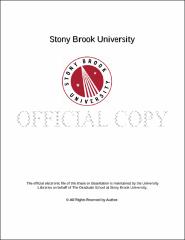| dc.identifier.uri | http://hdl.handle.net/11401/77133 | |
| dc.description.sponsorship | This work is sponsored by the Stony Brook University Graduate School in compliance with the requirements for completion of degree. | en_US |
| dc.format | Monograph | |
| dc.format.medium | Electronic Resource | en_US |
| dc.language.iso | en_US | |
| dc.publisher | The Graduate School, Stony Brook University: Stony Brook, NY. | |
| dc.type | Dissertation | |
| dcterms.abstract | A computational framework that combines the Eulerian description of the turbulence eld with a Lagrangian point-mass ensemble is proposed in this dissertation. Depending on the Reynolds number, the turbulence eld is simulated using Direct Numerical Simulation (DNS) or eddy viscosity model. In the meanwhile, the particle system, such as spring-mass system and cloud droplets, are modeled using the ordinary differential system, which is stiff and hence poses a challenge to the stability of the entire system. This computational framework is applied to the numerical study of parachute deceleration and cloud microphysics. These two distinct problems can be uniformly modeled with Partial Differential Equations (PDEs) and Ordinary Differential Equations (ODEs), and numerically solved in the same framework. For the parachute simulation, a novel porosity model is proposed to simulate the porous effects of the parachute canopy. This model is easy to implement with the projection method and is able to reproduce Darcy's law observed in the experiment. Moreover, the impacts of using different versions of k-epsilon turbulence model in the parachute simulation have been investigated and conclude that the standard and Re-Normalisation Group (RNG) model may overestimate the turbulence effects when Reynolds number is small while the Realizable model has a consistent performance with both large and small Reynolds number. For another application, cloud microphysics, the cloud entrainment-mixing problem is studied in the same numerical framework. Three sets of DNS are carried out with both decaying and forced turbulence. The numerical result suggests a new way parameterize the cloud mixing degree using the dynamical measures. The numerical experiments also verify the negative relationship between the droplets number concentration and the vorticity eld. The results imply that the gravity has fewer impacts on the forced turbulence than the decaying turbulence. In summary, the proposed framework can be used to solve a physics problem that involves turbulence eld and point-mass system, and therefore has a broad application. | |
| dcterms.available | 2017-09-20T16:52:03Z | |
| dcterms.contributor | Li, Xiaolin | en_US |
| dcterms.contributor | Glimm, James | en_US |
| dcterms.contributor | Liu, Yangang | en_US |
| dcterms.contributor | Charles, Richard. | en_US |
| dcterms.creator | Gao, Zheng | |
| dcterms.dateAccepted | 2017-09-20T16:52:03Z | |
| dcterms.dateSubmitted | 2017-09-20T16:52:03Z | |
| dcterms.description | Department of Applied Mathematics and Statistics | en_US |
| dcterms.extent | 162 pg. | en_US |
| dcterms.format | Application/PDF | en_US |
| dcterms.format | Monograph | |
| dcterms.identifier | http://hdl.handle.net/11401/77133 | |
| dcterms.issued | 2017-05-01 | |
| dcterms.language | en_US | |
| dcterms.provenance | Made available in DSpace on 2017-09-20T16:52:03Z (GMT). No. of bitstreams: 1
Gao_grad.sunysb_0771E_13237.pdf: 7993229 bytes, checksum: 1b2254369f9abe874a15c158f473363e (MD5)
Previous issue date: 1 | en |
| dcterms.publisher | The Graduate School, Stony Brook University: Stony Brook, NY. | |
| dcterms.subject | Mathematics | |
| dcterms.subject | computational fluid dynamics, fluid-structure interactions, particle system dynamics | |
| dcterms.title | Numerical coupling and simulation of point-mass system with the turbulent fluid flow | |
| dcterms.type | Dissertation | |

